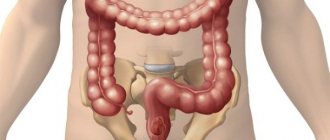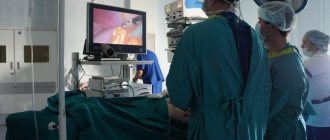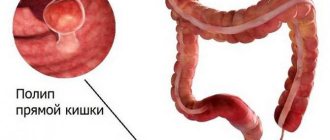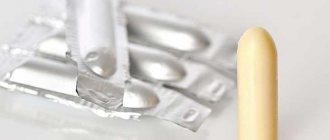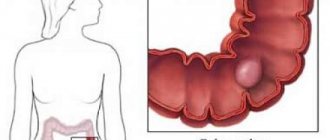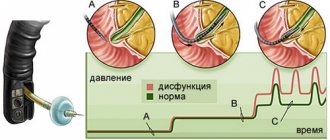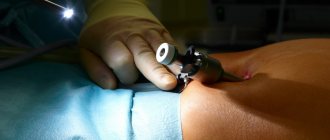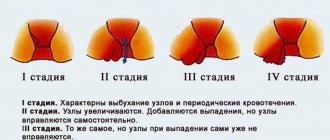A shallow vertical tear that forms in the anal area is called a “rectal fissure.” This pathological process develops as a result of excessive mechanical stress, labor and intestinal diseases. The mucous membrane and skin of the rectum are supplied with a huge number of nerve fibers. Excessive pressure on the anal area leads to damage to delicate tissues and provokes irritation. Systematic exposure causes cracks in the rectum, which bleed and hurt. Timely therapy completely eliminates discomfort.
Brief information about cracks
The disease was included in the International Classification of Diseases (ICD). Anal fissures are designated by code K60-60.5. This linear defect forms on the mucous membrane of the anus. Damage to the rectum occurs due to excessive sensitivity of nerve endings. This leads to frequent spasmodic contractions of the rectum, which complicates the process of defecation and makes it painful.
Constant trauma prevents the affected area from healing. The presence of pathogenic microflora in the intestines increases the likelihood of infection. Such features of the course of damage to the rectum, which is relevant for the development of an anal fissure, lead to the fact that the inflammatory process is always in an active form. The lack of conservative therapeutic effects aggravates the situation and necessitates surgical intervention.
According to the medical classification, there are two main forms of the disease: acute and chronic. The first develops during trauma, in most cases - accidentally. The crack that appears does not require specialized medical treatment. Timely hygiene procedures contribute to the independent healing of the rectum within several days. The chronic form of the disease develops when the rectum is subjected to constant mechanical stress, and pathogenic microflora and the lack of regular hygiene procedures delay the healing process and increase the possibility of infection.
A high probability of developing cracks in the rectum remains in women 18–59 years old and older men. All persons leading a sedentary lifestyle are also at risk. Pathology is often observed with chronic constipation and the presence of hemorrhoids.
Treatment
Fissure therapy is carried out by a proctologist who determines the medical or surgical method of treatment, and a combination of both is possible.
Modern coloproctology does not guarantee complete healing. Conservative therapy involves treatment by adjusting the diet. Warm baths, suppositories with belladonna, ichthyol, novocaine, sea buckthorn oil, and microenemas with chamomile are effective. This type is aimed at avoiding severe consequences and reducing acute pain.
Novocaine blockades of lesions and sprains of the anal sphincter are also used. In chronic cases, surgical intervention is indicated, consisting of excision of the problem area.
Prevention
Preventive measures include a number of actions. The patient should:
- promptly treat proctological diseases;
- avoid unnatural sexual intercourse through the anus;
- do not delay the natural reflex act of defecation;
- train the anal muscles by regularly squeezing and relaxing the perineal muscles in your free time (in transport, at work, at home);
- eat foods with a high fiber content and foods that lead to loose stools;
- avoid lifting heavy objects.
Causes of cracks
These pathologies in the rectum are formed under the influence of provoking circumstances. The main factors in the development of damage are:
- mechanical injuries;
- inflammatory processes in the gastrointestinal tract;
- haemorrhoids;
- pregnancy and labor;
- pathological spasms in the rectum;
- sedentary lifestyle;
- uncontrolled use of laxatives.
Compaction of stool, constipation or entry of a foreign object into the rectum are the main mechanical provocateurs of a fissure. Often, irritation and damage are provoked by anal intercourse. In childhood, the main cause of cracks is infection with helminths, as a result of which the anal area itches and itches, and scratching by a child leads to mechanical injury.
Cause of anal fissure
Inflammatory processes in the gastrointestinal tract increase the risk of cracks. The likelihood of pathology remains with cholecystitis and gastritis. Damage to the mucous membrane occurs with frequent constipation or diarrhea. Under the influence of the presented factors, there remains a high probability of developing bacterial erosion in the rectum.
Hemorrhoids are accompanied by constant injury to the hemorrhoids during defecation. Poor circulation, thrombosis and blood stagnation make the walls of the anus vulnerable to mechanical stress. Pregnancy and labor are also accompanied by pressure on the rectum. Malnutrition of the mucous membrane increases the vulnerability of the anus, which causes the development of a fissure. Pathological spasms in the rectum lead to bleeding and disruption of innervation. In this case, the disease takes a chronic form.
An anal fissure may be the result of systematic trauma. This happens, in particular, due to constipation.
Development of pathology in the postpartum period
At the stage of childbirth, a large load is placed on the female body, which can seriously affect the pelvic organs. During the passage through the birth canal, there is strong pressure on the anal area, which often leads to the formation of anal fissures after childbirth.
Sometimes cracks in the anal area occur only a certain time after delivery. In this case, the damage is most often provoked by chronic constipation, which developed in a woman from the fear of going to the toilet after childbirth. This is why proper preparation of a woman in labor for her first bowel movement is so important. To facilitate the passage of feces, a woman who has given birth may be prescribed herbal laxatives or microenemas.
Clinical manifestations of the disease
Anal fissures develop in two main stages: acute and chronic. The first can flow into the second. Each type of pathological process has its own set of symptoms.
Features of the acute form
This type of disease is accompanied by the following symptoms.
- Pain in the rectum and anus. The pain syndrome is tolerable and appears only after defecation.
- Spasmodic contractions of the anal sphincter.
- Mild bleeding from the rectum. Occurs during the act of defecation due to the passage of dense feces.
- Difficulty with bowel movements.
The acute form of the crack is characterized by spontaneous occurrence. This is due to a rupture of the rectal mucosa. In most cases, this process occurs with frequent constipation. The crack heals on its own and takes about 1–2 days.
Signs of chronic form
This is a serious variant of the disease. It is characterized by the appearance of prolonged pain in the rectal area. A crack formed as a result of acute injury is constantly exposed to unfavorable factors, which does not allow the damaged area to heal. The pain intensifies with prolonged sitting. Constipation causes bleeding and purulent discharge from the rectum.
The walls of chronic cracks are characterized by increased density. The complication of the process is recorded due to its duration and constant negative impact on the rectum. A person develops a fear of defecation. He understands that this will cause pain and general discomfort.
The duration of clinical manifestations and the time intervals between them will help determine the type of pathological process.
Prevention methods
Since treatment during pregnancy is not advisable, it is better to prevent the problem. A number of preventive measures will help minimize the risk of anal fissure.
First of all, it is worth minimizing the time spent on the toilet. It is advisable to spend no more than three minutes on the emptying process. At the same time, it is strictly forbidden to push, as this affects the condition of the rectum.
For the toilet, it is recommended to use soft types of toilet paper. It is important to take care of your diet. It is better to make vegetables and fruits as the basis. Minimizing fat provokes constipation.
To prevent the growth of bacteria, you should strictly follow the rules of personal hygiene: after each act of defecation, you should wash the anal area with water. Then Vaseline or baby cream with an antibacterial effect should be applied to the affected area to soften the skin.
Timely initiation of treatment and strict adherence to the doctor’s recommendations will help you quickly and effectively get rid of a serious problem in the anus.
Related video: Pain in the anus during pregnancy
An anal fissure during pregnancy most often develops against the background of congestive processes in the pelvic organs and when problems with bowel movement, natural for this period, occur. Pathology requires immediate treatment. Otherwise, serious complications may develop.
Anal fissure in a child
Damage to the rectum in children in most cases is caused by helminthiasis. Infection of the body with worms leads to the development of a number of unpleasant factors. Helminths cause severe itching in the anus. To get rid of it, the child begins to intensively scratch the affected area, increasing the likelihood of developing a crack.
Sometimes damage occurs due to the use of too hard toilet paper. To identify a pathological process, parents are advised to monitor the child’s behavior, especially after visiting the toilet. Often, due to increased pain, children refuse to defecate. Examination of the anus reveals redness and inflammation. Timely therapy reduces the risk of complications.
The danger of fissures during pregnancy and childbirth
Due to a sedentary lifestyle, unbalanced diet and changes in the expectant mother's taste preferences, she often experiences constipation and even hemorrhoids. The consequence of these processes is the development of anal fissures. It is necessary to deal with them in a timely manner during pregnancy. The lack of therapeutic tactics increases the risk of infection and suppuration of the affected area. In this case, the likelihood of complications during the birth process remains.
Hormonal changes in the body lead to a weakening of protective functions. Under the pressure of constant bacterial exposure, the crack does not heal for a long time. This process increases the likelihood of infectious inflammation, bleeding and the development of cancer.
A dangerous complication is paraproctitis (abscess) and blood poisoning. Timely therapy increases the favorable outcome and reduces any risks during childbirth.
Hemorrhoids are the cause of pain in the anus
The most common cause of hemorrhoids is persistent constipation. People with such problems should not push during bowel movements. In women, hemorrhoids most often appear during pregnancy. This occurs because the enlarged uterus puts strong pressure on the veins of the anus. Another factor that can cause hemorrhoids to develop is constant coughing and standing work. Hemorrhoids can also occur in people who are overweight, as well as in those who constantly lift heavy objects.
Depending on their location, cones can be external or internal. The external form of the disease differs in that the nodes are accessible for inspection. They look like small round formations the size of a pea to a cherry. Often the external nodes form a cluster in the form of a corolla around the anus.
With internal hemorrhoids, the lumps are located behind the anal sphincter. They cannot be seen, but often manifest as hemorrhoidal bleeding. As a result, posthemorrhagic anemia develops, which is dangerous during pregnancy and after childbirth. Other symptoms of the disease with the internal location of the nodes are also possible.
Diagnostic measures
A simple examination can detect cracks in the rectum. The damage looks like a longitudinal or triangular ulcer of a reddish hue. Upon palpation (digital examination) of the affected area, a spasm of the rectal sphincter is recorded.
To confirm the diagnosis and determine the degree of the disease, specialists resort to help:
- sigmoidoscopy;
- colonoscopy;
- irrigoscopy;
- profilometry;
- Ultrasound.
Sigmoidoscopy consists of examining the rectum and sigmoid colon. The main objective of the procedure is to exclude other inflammatory processes in the intestines. Colonoscopy is an endoscopic examination. During the procedure, the general condition of the rectum is determined.
Irrigoscopy is an X-ray examination of the intestine aimed at excluding inflammatory processes and additional lesions in the rectum. Profilometry allows you to evaluate the obturator function (maintaining the sphincter in contraction and inhibition of motor activity) of the rectum. Ultrasound is used when cancerous formations in the intestine are suspected.
Additionally, the doctor prescribes a bacteriological test to determine the pathogenic microflora that provokes inflammation and infection.
What is the basis of traditional medicine?
The generally accepted therapeutic effect for damage to the rectum is a set of measures: drug therapy, dietary nutrition, traditional methods and surgical intervention. The main goal of treatment is to eliminate the cause of the development of the crack and eliminate unpleasant symptoms.
Drug therapy
Acute cracks are treated using various groups of drugs. Experts recommend using a range of systemic and local medications. The first are presented in tablet form for oral administration and blockades, the second - ointments, gels and suppositories for external use.
Pills. These include anti-inflammatory drugs, vitamins, and laxatives. Eliminates inflammation and reduces the intensity of swelling "Salofalk". To speed up wound healing, it is necessary to take special complexes based on vitamins A and E. They help strengthen the protective mechanisms of the skin.
Laxatives are used to regulate bowel movements. Preference is given to medicines based on herbal components. The most popular drugs are Normaze, Duphalac, Lactulose and Sorbitol.
For spasmodic contraction of the sphincter and intense pain, novocaine or lidocaine blockades are used. They are placed at the base of the crack to relieve unpleasant symptoms. Systemic medications are complemented by local effects.
Ointments and creams. Creamy preparations must have a fatty base. They promote rapid recovery of the affected area, relieve inflammation and stimulate the healing process. The most popular products are “Ultraprokt”, “Aurobin”, “Dexpanthenol”, “Bepanten” and “Solcoseryl”. Ointments and creams are applied to the desired area from the outside or introduced into the anus using a special applicator.
Suppositories (candles). They are considered the most convenient dosage form. Inserted directly into the anus. The suppositories quickly melt and are absorbed into the affected area, which speeds up the healing process. Suppositories are inserted into the anus 2-3 times a day. The most popular medications are Anuzol, Anestezol, Proctosan and Relief.
Surgical intervention
The operation is performed if there is no positive result from previously used conservative therapy. The main indications for surgery on the rectum are as follows.
- Ineffectiveness of the therapy after two months of use.
- Chronic form of fissure with scarring.
- Narrowing of the anal canal due to prolonged spasmodic contraction.
- Combination of fissure with hemorrhoids and other pathologies of the anus.
Surgery is not recommended if the patient is in serious condition, has an acute infectious disease, has an inflammatory process, or is suspected of oncology. Surgery is also excluded if there is a high risk of bleeding due to a bleeding disorder.
Main types of surgical interventions
| Methods | Conduct and effectiveness |
| Excision. | In the process of influencing the rectal fissure, its altered edges are removed. This allows you to eliminate the chronic wound surface and get a fresh one that can heal quickly. The procedure is performed under local or general anesthesia, depending on the complexity of the intervention. The duration of the operation does not exceed 20 minutes. |
| Sphincterotherapy. | It is carried out with dissection of the internal sphincter. The procedure is carried out in open and closed form. The main task is to remove the affected area with sutures. Efficiency is 90%. |
| Pneumodivulsion. | It consists of using a special canister with the ability to pump air. The procedure allows you to relax the sphincter and eliminate the consequences of pathology. |
| Laser. | It is a modern and bloodless method of crack removal. After surgery there is no swelling. The recovery period is short, the patient is seen by a doctor on an outpatient basis. It is practiced in the presence of a fissure in the rectum and hemorrhoids. |
The optimal method of exposure is determined by a specialist based on the results of diagnostic measures and the general condition of the patient.
The main methods of treating a fissure in the intestine
First of all, the patient must understand that treatment must be comprehensive. If you simply eliminate the problem, but do not treat the root cause, then the symptoms will soon reappear. In other words, if a child has a crack due to helminths, then until he gets rid of them, the cracks will appear again. The same can be said about gastritis and other problems of the gastrointestinal tract. First you need to choose the correct and effective treatment for the main problem that causes the crack to appear.
To begin with, the doctor always prescribes complex drug therapy. If it does not produce any results, then surgical intervention will be required.
So, the main methods to combat this problem:
- gentle laxatives. Enemas with antiseptics are also very good for this purpose. Decoctions of medicinal herbs are perfect for this. Enemas should be done daily;
- anti-inflammatory and painkillers. To eliminate inflammation and swelling, use a suppository that must be inserted directly into the anus. Warm baths and enemas are good options for pain relief. In some particularly severe cases, the doctor may prescribe injectable drugs, which must be injected directly into the area of the crack;
- means for treating the underlying pathology that causes the crack.
Often, of course, such therapy brings quite successful results and this is quite enough to get rid of the problem. But if the disease has already entered the chronic stage, then an operation must still be performed. Otherwise, it will not be possible to get rid of overgrown granular formations and scar tissue.
In this situation, operations are carried out so-called bloodless. Laser coagulation or cryodestruction methods are used. These methods are so popular for the reason that they do not even require the use of general anesthesia and a long hospital stay.
If such a method of surgical intervention cannot be used (the area of the crack is too large), then a conventional operation under general anesthesia is used. In this case, the crack along with the scar tissue around it is cut out, and the edges are sutured. Anti-inflammatory therapy will need to be used for a month after this.
Home remedies: indications and contraindications
Traditional medicine is helpful in eliminating fissures in the anus. It can only be used according to the recommendations of a specialist. The duration of therapy and the number of sessions are discussed with the doctor individually. Many people practice home treatment for pathology.
However, the use of traditional methods should be abandoned in the following cases.
- No positive dynamics for 2 weeks.
- Chronic process (can be eliminated exclusively by surgery).
- Bleeding.
- Fecal incontinence.
- The occurrence of disorders of the gastrointestinal tract (nausea, vomiting, lack of appetite, abdominal pain).
- Sharp pain in the perineum.
- Increase in temperature.
- Suspicions of cancer.
Indications for alternative treatment are moderate cracks, without acute pain and associated symptoms. The main methods of home exposure include:
- sitz baths;
- candles;
- enemas;
- herbal decoctions.
Sitz baths are recommended to be done immediately after a cleansing enema. They help eliminate swelling and inflammation. The baths are based on decoctions of chamomile and potassium permanganate. To achieve a positive effect, the temperature of the healing liquid should not exceed 35 degrees. The time of exposure to the affected area is 15 minutes.
Candles. The most popular and effective method of eliminating inflammation is potato-based suppositories. To prepare them, you need to take the vegetable raw and cut candles from it 6 cm in size and 1.5 cm in diameter. Insert into the rectum overnight.
Therapeutic enemas. Helps gently cleanse the intestines and eliminate the inflammatory process. The composition is based on natural herbs and fats, in particular aloe juice, fish oil and raw egg.
Medicinal decoctions help cope with cracks. Healing potions are prepared from yarrow, St. John's wort, celandine and medicinal chamomile. Herbs are used both for personal hygiene and healing baths.
Colon fissure treatment with folk remedies
Most people are extremely reluctant to seek medical help from proctologists. Many people prefer to treat small anal fissures at home, using traditional methods.
Let's figure out whether treatment of rectal fissures is effective with folk remedies, and why some cases pose a particular danger and require immediate consultation with a doctor.
Such a crack is a small ulcer or longitudinal rupture of the mucous membrane. This is a very common pathology. The lack of proper treatment provokes constant discomfort in the anal area. Over time, it may intensify, and therefore medical care should not be neglected.
As a last resort, you should use folk remedies to treat rectal fissures. Two types of pathology are differentiated.
| Acute | The appearance of an ulcer can be caused by a gastrointestinal disorder. Constipation or diarrhea equally contribute to mechanical injury to the mucous membranes. In patients with good immunity, such cracks heal without treatment after restoration of normal functioning of the digestive tract |
| Chronic | The presence of concomitant pathologies and a weak immune system do not allow such cracks to heal without outside medical help. Lack of necessary therapy leads to an increase in the size of internal damage and bleeding |
In the future, non-healing erosions can cover larger areas and provoke the development of cancer.
The following factors are considered the most common prerequisites for the appearance of anal ulcers.
| Stool disorders | Constipation and diarrhea contribute to mechanical damage to the walls of the anus |
| Inactive lifestyle | Lack of physical activity leads to stagnation of blood in the pelvic organs. Impaired blood flow makes the intestinal walls thin and sensitive |
| Excessive force loads | Systematic overexertion leads to the appearance of tears in the rectal mucosa |
| Unbalanced, unhealthy diet | Lack of fiber causes constipation, and spicy, fried, salty and smoked foods lead to stagnation of blood flow. |
| Active labor | Cracks can appear from strong tension when pushing |
| Inflammation in other parts of the intestines or stomach | Running processes tend to develop in all directions |
| Inactive lifestyle |
Such diseases increase the vulnerability of the anal mucosa.
For more information about rectal fissures and the reasons for their occurrence, watch the video:
It is quite easy to suspect this pathology. Most often, patients note the following characteristic symptoms:
- pain during or after going to the toilet. The discomfort is more severe if a person sits down;
- itching and burning in the rectum;
- anal spasm;
- bleeding;
- purulent discharge - a symptom indicating advanced pathology.
The presence of one or more signs is a serious reason to contact a proctologist.
The doctor can make a final diagnosis after a rectal examination. If possible, a sigmoidoscope is used for examination - the device allows you to visually assess the dislocation and depth of the ulcer.
The acute form is characterized by linear damage with smooth edges. Chronic fissures have an oval or triangular shape surrounded by scar tissue.
To complete the picture and select treatment options, the patient must additionally undergo blood and stool tests. If we are talking about a small child, it is necessary to conduct a stool test for the presence of worm eggs.
If treatment is neglected, over time the crack may increase in size and become chronic. In the future, the development of concomitant diseases is possible: paraproctitis, fistulas, prostatitis, colitis.
Chronic inflammation also contributes to the appearance of tumors.
To eliminate this pathology, modern medicine practices an integrated approach. In addition to taking medications, the patient must change their usual lifestyle. We are talking about a dairy-vegetable diet, which is necessary for soft stools.
It is also important to eat fiber-rich raw vegetables to help prevent constipation. With constant low mobility, the patient needs to allocate time for physical activity. You can do morning exercises, jog or take long walks.
As an auxiliary therapy, patients are shown enemas with medicinal herbs. Plants that have antiseptic properties should be brewed.
To relieve pain and stop the inflammatory process, doctors prescribe appropriate medications in the form of rectal suppositories, ointments, and microenemas. In severe cases of the disease, injections into the damaged area are practiced.
If the root cause of the disease is gastritis or cholecystitis, they should be treated. Otherwise, these pathologies will constantly provoke the appearance of new ulcers.
If all points of complex treatment are followed, patients recover without surgery. However, particularly advanced cases with a large area of lesions must be operated on. During the operation, the edges of the ulcer are excised, and then the edges of the wound are sutured. There are also more gentle modern methods - laser coagulation and cryodestruction.
Small cracks can be treated quite successfully using folk remedies. The methods used do not contradict the recommendations of traditional medicine. Medicinal herbs in various forms are used to treat pathology. These can be decoctions for oral administration or for anti-inflammatory enemas.
The use of chamomile, sage, oak bark, and yarrow is effective. Traditional medicine advises adding aloe or Kalanchoe juice to the solution for microenemas.
The patient should follow a diet rich in fiber. The daily menu should include vegetables, fruits, fermented milk products, and cereals. You need to drink 1.5-2 liters of clean water per day. A large amount of liquid helps soften the stool.
If possible, the patient should avoid flour, salty, pickled, and smoked foods. The use of alcohol and tobacco should be minimized at least during the period of exacerbation of the pathology.
It is practiced to treat cracks with propolis - it is crushed, olive oil is added and, stirring, heated for about 40-50 minutes in a water bath. The prepared mixture must be filtered and cooled. This ointment is used for internal treatment.
A very good remedy is a homemade rectal suppository made from raw potatoes. The candle relieves pain and reduces discomfort. It is cut out immediately before insertion. For greater effect, it can be treated with sea buckthorn oil.
We invite you to watch a video about the treatment of rectal fissures with folk remedies:
Quick relief from anal fissures is possible if treatment is started on time. At the first suspicion, it is necessary to take measures to normalize stool. Diet and herbal enemas are also an effective method for quickly healing small ulcers.
Unfortunately, advanced chronic pathologies do not go away quickly. In this case, treatment will require at least 2-3 weeks, and if the condition does not improve during this period, the patient is indicated for surgical intervention.
Anal fissure is one of the few problems for which there are truly effective folk remedies. However, it should be understood that the treatment of chronic diseases with extensive lesions requires the supervision of a qualified proctologist.
- Download Original]» >
- Download Original]» >
- Download Original]» >
- Download Original]» >
- Download Original]» >
- Download Original]» >
- Download Original]» >
I encountered this problem after giving birth. I suffered for more than a month until my mother told me to lubricate the area with sea buckthorn oil and put homemade potato candles at night. Helped heal cracks in a few days.
source
This pathology can have different names: rectal fissure, anal fissure, anal fissure, but the essence of the disease becomes clear from any of them. A painful slit-like ulcer, localized at the junction of the anal mucosa into the skin; as a rule, in appearance it has the shape of a triangle located on the rectum.
When treating this disease, the patient is prescribed a gentle diet, the purpose of which is to soften the stool; in addition, oils are used to relieve pain, and laxatives are used. The disease often plagues young children; when a child sits on the potty for a long time, an infection can get into the crack, which provokes inflammation. You should avoid eating foods that can irritate the rectal mucosa, for example, avoid spices and marinades. Fermented milk products are recommended: kefir, fermented baked milk, yogurt. For persistent constipation, you should use bran; in addition, there are other folk remedies for the treatment of rectal fissures, which we will consider further.
1. Folk remedies such as aloe and fish oil are used to treat rectal fissures. To prepare the product, you will need a three-year-old aloe, from which you need to squeeze the juice, measure it into 1 tbsp. and mix with the same amount of fish oil, add 1 raw chicken egg, mix thoroughly and pour into a syringe. The product is injected into the rectum regularly; it will take 10-15 procedures to completely get rid of an anal fissure.
We advise you to read: Bursitis of the ankle joint, symptoms and treatment with folk remedies
2. Dandelion has an excellent effect in treating anal fissure. To use, you will need powder from the root of this plant, which you simply need to eat 1 tsp 3 times daily. An infusion made from yarrow herb will help to enhance the healing process - they should be washed down with dandelion powder. Preparing the infusion is not difficult: you need to chop the herb, measure out 2 tsp. and pour boiling water (1 cup). After the product has infused for 30 minutes, it must be strained and washed down with the powder while the infusion is warm. It is especially useful to use this remedy when a crack is neglected and does not heal for a long time.
3. Folk remedies such as motherwort herb, plantain herb, and chamomile flowers are recommended for the treatment of advanced rectal fissures. Measure everything into 1 tsp. and pour into pre-melted beeswax (about 130 g). Mix everything together and make candles (10 pieces) from this product and insert it into the anus 3 times every day. Pre-prepared candles should be stored in the refrigerator.
4. As mentioned above, when treating anal fissure, you should eat bran. They are contained in some special types of bread, but in addition, the following remedy should be prepared from bran: take the bran, steam it with boiling water and eat 1 tsp in its pure form. 3 times a day. You can mix it with other foods and gradually increase the dose of bran eaten over time so that it reaches 2 tbsp. 3 times a day.
5. The following remedies have excellent effects and are very useful. Take 1 part celandine herb and 3 parts each of common yarrow herb, St. John's wort herb, chamomile flowers, mix, measure 2 tbsp. collection, pour boiling water (1 glass), put in a warm place, wrapping the container in a towel and let it brew for 2-3 hours. Drink 4 times a day, ½ glass.
6. Separately, it should be said about the hygienic measures taken, which should become mandatory when treating anal fissures. After each bowel movement, the anus should be washed with cool water; the use of newspaper and other thick paper as toilet paper is strictly contraindicated. During treatment, it is recommended to completely abandon toilet paper, replacing this process with washing the area.
7. Therapeutic baths for the treatment of anal fissures. You can use a warm solution of potassium permanganate for these purposes, but it is also useful to use such a folk remedy as onions boiled in milk. This will require 0.5 liters of milk and 4 medium-sized onions. Place the onions in the milk, cover the pan with a lid and place on the lowest heat. Pour the hot broth into a vessel that needs to be closed with a lid with a small hole, sit so that the anus area is above the hole, and the steam reaches the area affected by the disease. This procedure is repeated once every week.
8. Folk remedies can be used not only to treat rectal fissures, but also for preventive purposes. To do this, prepare an ointment from propolis. Take solid propolis, crush it with a knife, mix with any vegetable oil in a ratio of 1:3 and place in a water bath. Heat for 45 minutes, stirring occasionally, while the wax should settle to the bottom and the beneficial substances from the propolis should be released into the oil. At the end of the procedure, the oil should take on a darker color than usual. Next, the oil is carefully drained without mixing with sediment and stored for a long time. Lubricate the anal mucosa regularly; the product is also applicable to prevent the occurrence of other inflammations, including in children.
Did you like our site? Join or subscribe (you will receive notifications about new topics by email) to our channel in MirTesen!
source
The large intestine and its treatment with folk remedies in folk medicine have always been under close attention. After all, human health largely depends on the condition of this organ. Therefore, we have collected a lot of recipes for treating the colon, and we tried to select the best ones for you.
Among diseases of human internal organs, the most common are intestinal diseases. For this reason, the question of methods of treating the intestines is always relevant.
If you consult a doctor in a timely manner, it is quite possible to treat intestinal diseases using traditional medicine without drug therapy.
This is an infectious disease that occurs as a result of eating foods contaminated with dysentery bacteria. The causative agents of the disease belong to bacteria of the intestinal family.
1. Brew 30 g of fireweed in 1.5 cups of boiling water and boil for a few more minutes. Leave to brew. Drink half a glass before eating.
2. Place 10 g of wild rosemary leaves, 25 g of marshmallow root in a 1-liter jar and pour boiling water over it. Wait until the broth cools down and strain. Take 20 ml every 3 hours.
Colitis is a disease of the large intestine, as a result of which the mucous membrane becomes inflamed. It develops mainly from systematic violations of nutritional rules or infection with pathogenic viruses and bacteria.
1. Soak 100 g of oatmeal in cold water for 4 hours. Then pour in another 1 liter of hot water. Cook over low heat until the porridge thickens, stirring occasionally. You can add a little sugar and salt to taste. Drink the strained oatmeal broth between meals.
2. Pour 40 g of raspberry leaves with 2 cups of boiling water. The product should sit for at least half an hour. Drink half a glass of medicine before meals.
Disturbance of the microflora of the large intestine due to medications, periodic stress or unhealthy diet is called dysbiosis.
1. Treatment with propolis is very effective for dysbiosis. You need to drink 10 drops of propolis tincture (20%) some time before eating.
2. Pour 1 tbsp. l. Potentillas with a glass of boiling water and boil for several minutes. Leave it to sit overnight. Drink 150 ml three times a day.
3. For diarrhea, boil oak bark over low heat in the ratio of 30 g of the preparation per glass of water. After boiling for a short time, turn off and leave for the broth to cool slightly. Take 150 ml morning and evening.
Worms are parasitic worms that can live in the human body, affecting individual organs and affecting health. Many types of these parasites live in the large intestine.
1. Remedy for pinworms and tapeworms: make a paste from 2 cloves of garlic and mix with a glass of pre-boiled water. It should not be hot, but warm. Let it brew for 4 hours. A few hours before bedtime, make an enema from the tincture. Every time after an enema you need to chew onions. Treatment is carried out for a week.
2. For pinworms, you need to brew 15 g of wormwood in 0.4 liters of boiling water and leave until the tincture has cooled completely. Take 40 ml in the morning, at lunch and in the evening some time before meals.
Remedies for chronic enterocolitis
This disease is the most common. It develops through infection with intestinal infections, as a result of alcohol abuse, spicy food, long-term treatment with antibiotics, and radiation damage. As a result of the disease, the intestinal mucosa undergoes atrophic changes.
1. Mix 60 g of senna, 20 g of licorice roots and anise fruits, 40 g of alder buckthorn bark and laxative joster berries. Brew like regular tea. Take the product hot after dinner.
2. Prepare a herbal mixture from alder buckthorn, marshmallow root, fennel fruit and licorice root. Take half a glass as a decoction some time after meals.
1. For chronic constipation, chop 100 g of dried apricots and figs, 200 g of prunes and mix with 150 g of honey. The product must be stored refrigerated. Take 1 tbsp a few hours before bedtime. l. Drink water immediately.
We advise you to read: Folk remedies for angiopathy of the lower extremities
2. For flatulence - brew 15 g of ginger root and lemon balm in a cup. Leave for a few minutes. Drink the product in the first half of the day.
3. Against diarrhea - mix caraway fruits, cinquefoil roots, sage, immortelle flowers and blueberries in equal quantities. Place 20 g of the medicinal mixture in a cup and pour boiling water on top. It's good to insist. Divide the tincture into 3 parts, which should be drunk throughout the day in intervals between meals.
4. After food poisoning, chop and take marshmallow root, fennel fruit and licorice root in equal proportions. Brew like regular tea. Drink half a glass of tincture three times a day.
5. For intestinal spasms, mix crushed fennel fruits and valerian root. Pour boiling water over 15 g of the product in a cup. Leave for a few minutes and drink in one gulp. Take the product three times a day.
6. To improve intestinal motility, brew 1 tsp in a cup. toadflax. Take strained in small sips all day long.
In the large intestine, active absorption of water and some micro/macroelements occurs, and feces are formed and prepared for excretion. This section of the digestive tract is very important, since its work determines how quickly our body gets rid of toxins and waste.
Infectious diseases that are localized in the intestines, inflammatory processes or neoplasms of various origins should be treated by a specialized specialist (infectious disease specialist, gastroenterologist or oncologist). At home, we can only maintain the health of the large intestine. For example, consume fermented milk products, foods containing fiber, maintain a drinking regime, give up bad habits and fast food.
For any diseases and disorders of the large intestine, it is very important to adjust your diet. To improve intestinal functions, it is recommended to eat apples, fresh vegetable salads, fish and seafood, herbs, and dairy products every day. It is advisable to reduce the amount of meat in the daily diet. White bread should be replaced with black bread made from wholemeal flour.
Regular exercise has a beneficial effect on the intestines. They stimulate peristalsis and improve blood circulation in the intestines.
The intestines occupy an important place in the digestive system. Therefore, it is necessary to monitor his condition and provide timely treatment. Simple and effective folk remedies can easily overcome diseases in the early stages of development. But before using them, you should consult your doctor.
source
A rectal fissure is a disruption of the mucous membrane of the anal canal. This problem can occur at any age, regardless of gender. The disease occurs more often in young children than in schoolchildren.
Initially, a surface crack of a small size, several millimeters in length, may form. In the future it increases and becomes deeper. Its size can be up to 15 mm, especially in children who suffer from frequent constipation. An increase in the crack leads to a reflex contraction of muscle tissue, which is accompanied by pain and interferes with its healing.
The resulting fissure in the rectum has a slit-like shape. It has soft edges and a red bottom, which is muscle tissue.
If the first manifestations are left without proper attention and timely treatment is not started, the situation will worsen. The crack takes on an oval shape, and a fibrinous coating forms along the edges and bottom. Over time, the pathology can become chronic.
Violation of the rectal mucosa can be caused by various factors. Most often, this manifestation occurs as a result of mechanical damage and inflammation of the stomach. A combination of factors increases the possibility of rectal injury in children.
In the digestive system, all organs are interconnected. Inflammation that occurs in one section spreads throughout the entire tract. A characteristic phenomenon occurs in the presence of worms, which cause inflammation and swelling of the lower intestine. Worm eggs cause severe itching, in which the child, scratching the anus, causes mechanical damage to himself. The condition is complicated by passing feces.
Incompletely formed digestive organs in a child often cause diarrhea or constipation. Liquid masses irritate the inner surface of the rectum and cause swelling. With constipation, the mucous membrane is damaged by hard feces or the passage of a foreign body.
Other causes that can lead to damage to the rectum cannot be ruled out.
These include:
- Haemorrhoids;
- Laxatives taken for a long period;
- A perverted form of sexual violence;
- Regular consumption of smoked and spicy foods;
- Mechanical damage caused by improperly performing a diagnostic examination of the rectum.
The first sign that a rectal fissure has appeared is the occurrence of acute pain in this area. Pain may occur unexpectedly and last for a long period. Symptoms worsen with or after bowel movements.
If a rectal problem occurs in a baby, the baby begins to cry a lot during bowel movements. Older children complain of pain after going to the toilet. Some of them specifically try to delay the passage of stool in order to avoid sharp pain. Children refuse to sit on the potty for fear of pain. If you notice changes in your child’s behavior, you should urgently consult a specialist for advice.
In school-aged children, pain in the anus causes discomfort. They refuse to undergo a medical examination. Parents can convince the child by explaining the seriousness of the disease.
The main symptoms that determine the problem are:
- Frequent constipation;
- Presence of blood in the stool;
- Restless behavior of the child in the toilet;
- Feeling of discomfort in the rectal area;
- Pain that occurs after going to the toilet.
If signs of a disease are detected, the child should be immediately examined by a specialist.
The doctor examines the rectum. When palpating the problem area, the inflamed area is treated with anesthetic agents. If the child behaves restlessly, the mother can conduct a visual examination of the rectum at home on her own. To do this, you need to carefully spread your buttocks to the sides and examine the anus. If the crack is not visible, parents are not allowed to feel it from the inside. A more thorough examination requires special medical education.
An anal fissure in a child usually occurs as a result of trauma to the rectum caused by the dense consistency of feces. Therefore, treatment of children begins with stool restoration. When constipation is eliminated, the damaged area can heal on its own.
To soften stool, the doctor prescribes flax seed or petroleum jelly. It is necessary to follow a therapeutic diet and apply local treatment prescribed by a doctor. Usually, the doctor recommends cleansing the stomach with an enema and taking warm sitz baths with the addition of manganese solution or chamomile decoction. To heal the skin in damaged areas, ointments are used that have regenerative properties. Procedures are carried out daily, usually in the evening.
If a child has neurotic constipation, he needs to be shown to a neurologist. After an examination, the specialist may prescribe sedatives. Also, the possibility of disruption of the gastric microflora and the presence of worms cannot be ruled out.
Treatment of rectal fissures in children is carried out with suppositories containing sea buckthorn oil. To administer the drug into the anus, the child must be placed on his side or back. Raising your legs, gain access to the inflamed area, carefully introduce the product into the anus and squeeze the buttocks for three minutes. For babies under one year old, the procedure is carried out twice a day, half a candle, and older children are given a whole one.
An anal fissure causes a lot of pain. To speed up its healing, use Levomekol or Flocaine ointments. When carrying out treatment with medications, you must strictly observe the dosage and duration of their use.
Conservative treatment of rectal fissures is carried out, as a rule, without the use of antibiotics. The prescribed course of treatment improves the patient's health condition. It reduces pain and reduces spasms. Timely consultation with a doctor and compliance with the recommendations received allow you to complete the course of therapy without complications.
If drug treatment is ineffective and the signs of pathology do not disappear, surgical intervention becomes necessary. Typically, surgery is performed for chronic forms of anal fissures.
We advise you to read: Loose tooth - folk remedy for pain
If necessary, rectal fissures are removed surgically. A week after the operation, the wound is healing. To avoid relapses and anal fissures do not recur, muscle fibers are cut during surgery.
After the operation, hygiene procedures must be carried out. They consist of treating the anus with antiseptic agents and water procedures after bowel movements. It is imperative to monitor the nature of the stool.
Treatment of various diseases associated with the functioning of the digestive system depends entirely on diet. Products should cleanse the stomach and help loosen stools. It is recommended to consume fresh fruits and vegetables, dairy products, and be sure to increase fluid intake.
It is not recommended to consume baked goods, carbonated drinks, fried, spicy and fatty foods. Proper nutrition will help relieve your child of constipation and normalize intestinal function.
Beeswax
The most effective and affordable method of treatment at home is the use of rectal suppositories made of natural wax. To prepare them, take 155 grams of wax, add a few grams of crushed dried chamomile, plantain and motherwort flowers.
Mix the wax mixture thoroughly, roll into small cones, and leave in the refrigerator to harden. Use homemade suppositories 3 times a day until all symptoms of the disease disappear.
Herbal ointment
To prepare a homemade ointment, you need to mix chamomile, St. John's wort and calendula in equal parts.
Take 1 part of the herbal mixture and combine with 3 parts of hot olive oil. After cooling, store the ointment in the refrigerator. Use for treatment until complete recovery.
It is important to remember that regardless of whether treatment is carried out with pharmaceutical or folk remedies, it is very important to eat properly.
The foods eaten must have laxative effects. This diet must be strictly followed after surgery throughout the course of treatment and rehabilitation period.
source
One of the diseases with which people are increasingly turning to the doctor is an anal fissure - a rupture or cut in the anal mucosa, which causes discomfort and unpleasant sensations to the patient. Therefore, the issue of treating and eliminating the symptoms of rectal fissures remains relevant.
Among the main causes of the disease are constant problems with stool, inflammation of the digestive organs, and injuries caused by mechanical objects. Often cracks occur against the background of other diseases. Treatment of fissures that appear in the rectum is mandatory when the first alarming symptoms are detected. Otherwise, the disease becomes chronic.
Doctors call several symptoms of a fissure in the rectum:
- Pain localized in the anal area. They can be quite strong and occur not only during bowel movements, but also in other cases, for example, after sitting in one place for a long time.
- Bleeding. As a rule, it is small, scarlet in color and does not mix with feces. The appearance of bleeding is caused by the passage of solid feces through the affected area.
- Problems with bowel movements and, as a rule, constipation. The cause is pain. Patients often develop stool sensitivity, which aggravates the course of the disease.
Another symptom of rectal fissure that occurs in women and men is purulent discharge, which is associated with poor anal hygiene or lack of treatment. If the wound becomes infected, swelling of the anal area may occur. In addition, signs of intoxication of the body develop: high fever, weakness, pale skin.
Many patients are interested in how and what to treat a fissure in the rectum if the disease has become chronic. To do this, you can use folk recipes that have been proven over the years - homemade candles, compresses, baths. A combination of different methods of therapy will provide a quick solution to the problem.
- Traditional medicine recipes
To treat rectal fissures and eliminate symptoms, various folk remedies are used:
- Fish oil and aloe juice. The components are mixed with a raw chicken egg and inserted into the anus using a syringe. Fifteen procedures should be performed to heal wounds.
- Dandelion root powder – this should be taken orally. The positive effect of the product is enhanced by yarrow. The herb needs to be brewed and left for thirty minutes. Take the infusion warm.
- Plantain, motherwort and chamomile. The herbs are mixed with beeswax, which must first be melted, and candles are made, which must be inserted into the anus.
Hygiene plays an important role in the treatment of rectal fissures carried out at home.
The anus should be washed with warm water after each bowel movement. And it’s better to forget about toilet paper.
Baths have a good effect in the fight against rectal fissures. A chamomile decoction or a solution of potassium permanganate is suitable for their preparation. They have excellent anti-inflammatory properties.
Onions boiled in milk are very useful. The hot broth is poured into a container and covered with a lid with a hole. The patient should sit so that the escaping steam reaches the anus area. Carry out the procedure once a week. A bath with the addition of knotweed herb, hop cones and olive oil is no less effective. The herbs must be poured with boiling water and simmered on fire for three minutes, then infused. The finished mixture is sent into a wide basin, after which you sit down to completely wash the problem areas. Baths are recommended after bowel movements and careful hygiene.
One of the most common methods of treating chronic rectal fissures and eliminating the symptoms of the disease is cold suppositories, which have hemostatic and analgesic properties. To prepare you will need tansy, birch leaves, chamomile and sage. The mixture is brewed, infused and filtered. The finished infusion must be frozen in the form of candles, and then inserted overnight. The pain subsides after the first procedure.
Potato suppositories are suitable for cases where there is no bleeding or severe pain. It is very simple to prepare them: a piece is cut out of raw potatoes, similar to a rectal suppository. Candles are inserted into the anus before going to bed, after dipping them in honey. Candles made from corn flour and plantain will cope with even the most advanced cracks. Grind the leaves of fresh grass, squeeze out the juice, add flour to it and knead into a thick dough. Make candles out of it and put them in the freezer.
Compresses can also be used to treat a fissure in the rectum. They are placed at night, so they are more effective. Recipes may vary:
- Grind ambrosia pigweed, brew it and boil. Cool the broth and soak gauze in it, then apply it to the problem area. In the morning, wash with clean water.
- Brew raspberry leaves and leave in a closed container. After half an hour, you can make compresses from the infusion. In addition, the product can be taken orally - it will help normalize the functioning of the rectum and relieve inflammation.
- Dissolve propolis in soft butter, apply the mixture to a napkin and apply to the anus.
When answering the question of how to treat a rectal fissure at home, one cannot help but mention proper nutrition. Fermented milk dishes should be present in the diet - they normalize intestinal function. Dishes containing fiber are also beneficial. This can be prunes, wheat bran, boiled carrots and beets. Doctors allow the consumption of boiled meat, broths, and boiled eggs. It is better to avoid sour, smoked and spicy foods forever. A sufficient amount of fluid helps maintain water-salt balance.
If left untreated, an anal fissure can cause dangerous consequences:
- bleeding, which increases the risk of anemia;
- wound infection with subsequent suppuration and fistula formation;
- weakness of the external sphincter;
- formation of malignant tumors;
- paraproctitis;
- menstrual cycle disorders in women.
To prevent the development of complications, when the first signs of illness appear, you should consult a doctor.
The main part of preventive measures is following a diet that helps eliminate chronic constipation. In addition, doctors recommend:
- increase physical activity;
- exercise;
- avoid hypothermia;
- When working sedentarily, take breaks more often.
If you follow these simple rules, an anal fissure will never bother you. Remember that it is easier to prevent a disease than to treat it later.
source
Diet food
When a crack develops, the diet should be balanced and complete. Its main task is to adjust the chair. The diet includes daily consumption of fruits and vegetables. They are rich in coarse fiber (fiber), which improves intestinal motility. Small meals are encouraged: 4–5 times a day.
The list of permitted products includes:
- fermented milk drinks;
- fresh and dried fruits;
- berries;
- vegetables;
- lean chicken meat.
All products are prepared exclusively by steaming or boiling. In this form, food is well absorbed by the body and normalizes the functioning of the gastrointestinal tract.
List of prohibited products:
- smoked meats;
- fatty foods;
- fast food;
- strong drinks (alcohol, as well as tea and coffee);
- spices and spicy foods;
- chocolate;
- flour products.
The presented products are irritants, they contribute to the aggravation of the situation. Dietary nutrition for cracks is an obligatory component of a complex of therapeutic measures.
Possible complications
A dangerous consequence of untimely treatment of the rectum is a high risk of infection. With ascending inflammation, the likelihood of affecting most of the intestine remains. An acute process increases the risk of developing paraproctitis. The disease promotes inflammation of fatty tissue, which is accompanied by a number of unpleasant symptoms.
Fissures increase the likelihood of heavy bleeding. Systematic blood loss leads to anemia. When fissures become infected, especially in men, there remains a risk of infection spreading to the prostate gland. This process is dangerous due to the occurrence of prostatitis.
Preventive actions
To prevent the development of cracks, certain rules must be followed. First of all, you need to normalize your diet. This action allows you to avoid constipation and, as a result, mechanical damage to the rectal mucosa. In addition to the diet, it is necessary to establish a drinking regime. Experts recommend drinking at least 2 liters of still water per day.
Bowel movements should be done on time. Retention of feces leads to its hardening, which injures the mucous membrane. After each bowel movement, it is necessary to wash the anus area. Finally, moderate activity and exercise have a beneficial effect on bowel function and prevent inflammation.
Cracks formed in the rectum cause a lot of inconvenience to a person. They lead to the development of pain, discomfort and spasmodic contractions. All this negatively affects a person’s quality of life and increases the likelihood of surgical intervention. Proper nutrition, exercise and timely elimination of diseases will prevent possible complications.
ethnoscience
A fissure in the anus can be treated if you use folk remedies. They have a gentle effect on tissues and do not have a negative effect on a pregnant woman. If you follow a diet, after eliminating constipation, folk remedies can completely get rid of the problem without the use of medications.
Traditional medicine for anal fissure
Anal fissures can be treated with:
- aloe. Fresh juice is injected into the anus (contents of 2-3 full pipettes). The procedure is done before bedtime;
- sea buckthorn oil. They treat damaged skin with it and add it to water for compresses;
- mumiyo. 5 g of the substance is dissolved in a glass of water. The resulting solution is applied to damaged areas of the skin;
- propolis ointment. To prepare the remedy, dissolve 100 g of natural butter. This can be done in a water bath or in a microwave oven. Add 10 g of finely chopped propolis to the liquid oil. The mass is brought to readiness over low heat at a temperature of 80 degrees. The process will take 30 minutes. The resulting ointment is periodically applied to the anus;
- herbal infusions Prepared from chamomile, calendula, oak bark, St. John's wort, sage. Use 20 g of herb per 5 liters of water. The buttocks are dipped into the warm liquid. Take a bath for 15 minutes daily.
You may also be interested in: Ointment for healing cracks in the anus
